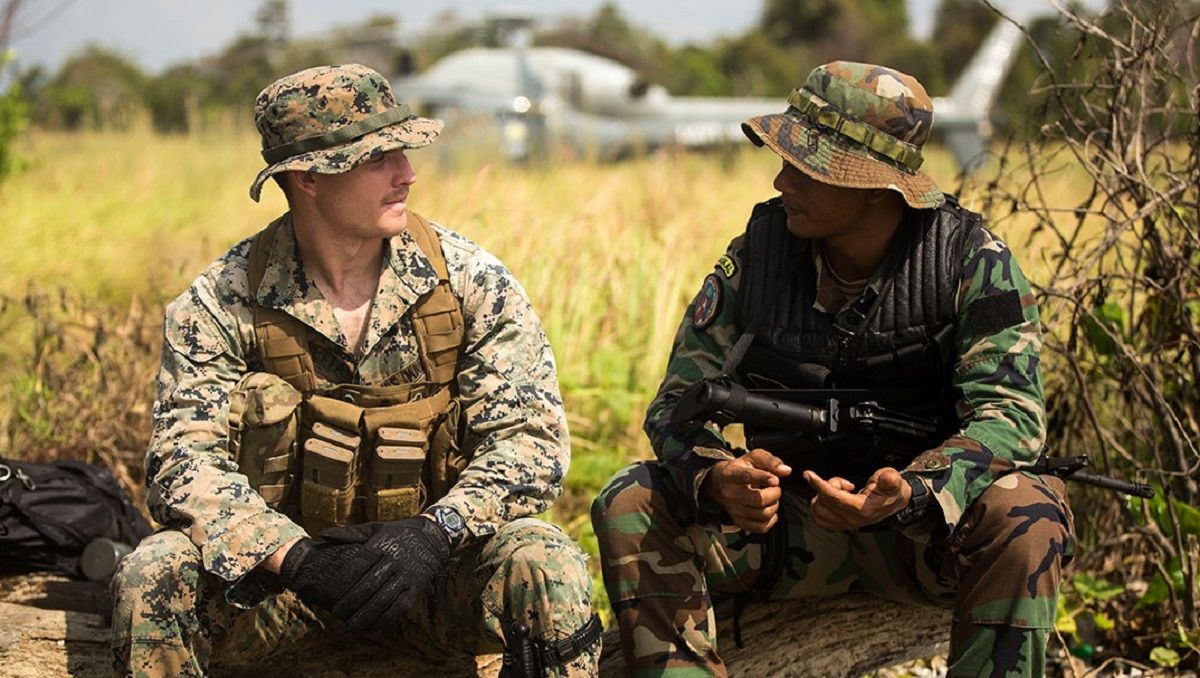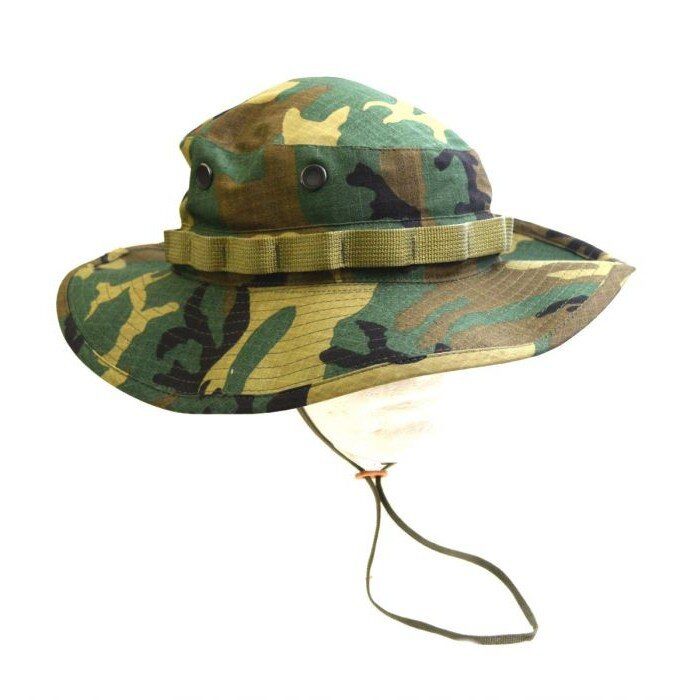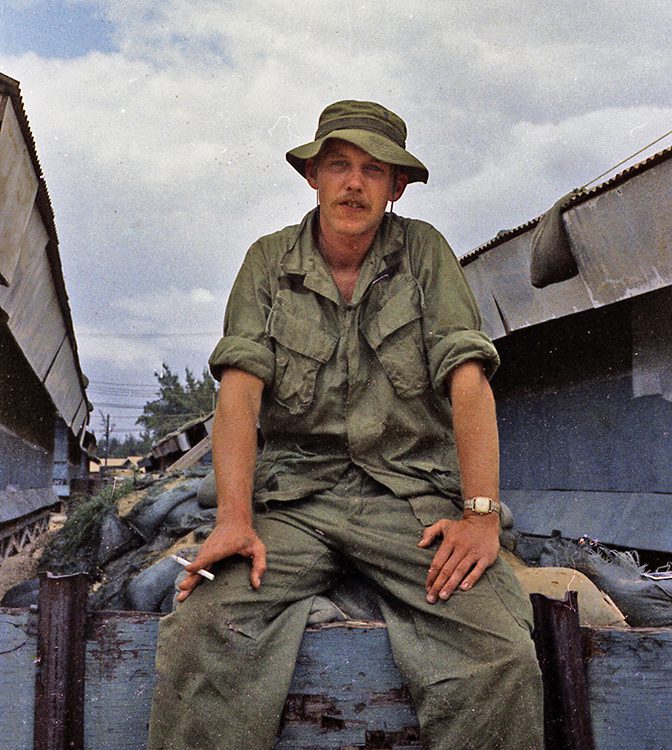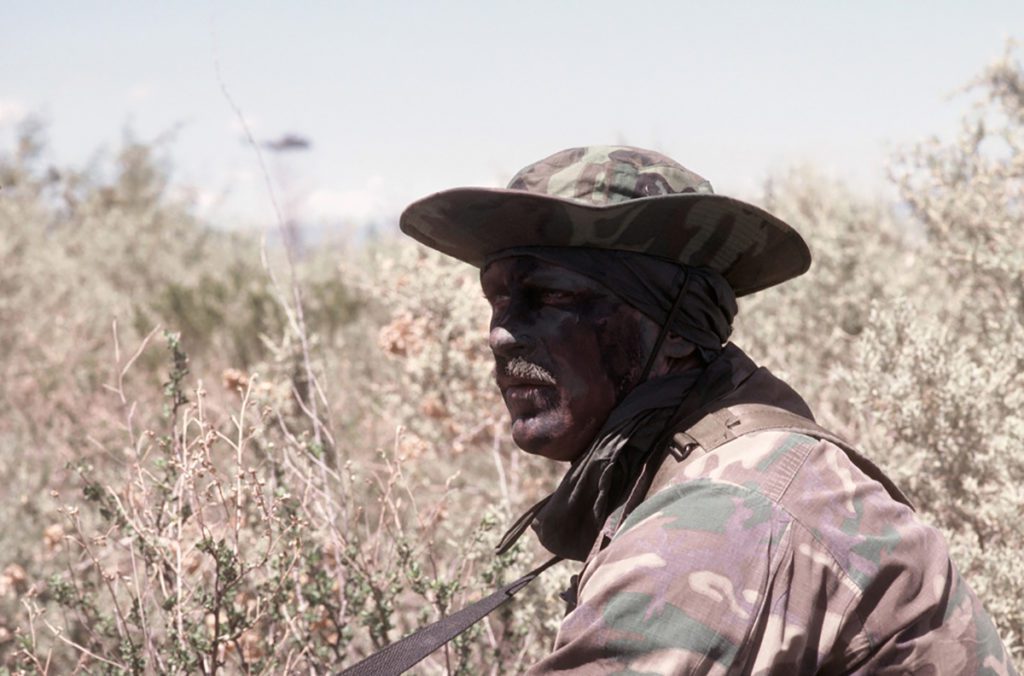
Boonie Hat History, Hacks, and Uses
The boonie hat is a practical and versatile cover specially crafted for hot tropical climates and summer sun. A long-time favorite of military forces, boonies are gaining popularity with a wider audience because of their versatility.
This article covers all things boonie cover. Learn what makes this hat great, how it evolved, and its many uses and hacks.

Anatomy of a Boonie Cover
Boonie hats are wide-brim military hats specifically designed for hot climates, offering essential protection from the sun and rain.
The crown of the boonie hat may feature vented eyelets or small mesh panels, promoting increased breathability during wear. These hats evolved as cool and functional headwear for troops navigating the hot jungles of Southeast Asia. Boonie covers provide an effective means to break up the wearer’s head shape in foliage—beneficial for snipers and recon missions.
These hats have a fabric tape band called “branch loops” encircling the crown. They enable wearers to attach additional vegetation for camouflage, creating a “foliage ring” effect.
A chin strap helps secure boonies in windy conditions. But it’s more comfortable for many to fasten it around the back of the head.
The brim of the boonie cover has many advantages. It’s semi-stiff and effectively keeps most branches out of the wearer’s eyes. It’s also flexible enough to allow for rolling up the front or back, which ensures better sightlines and prevents interference when wearing packs.
The “Cowboy roll” is a popular modification, achieved by using the chin strap to roll up the sides of the hat, resulting in a stylish appearance. However, it’s worth noting that this method may diminish the sun protection and concealment factor of the hat. Additionally, many boonie hat users modify the brim to suit their preferences. More on that later.
One of the boonie hat’s primary features is its portability and lightweight nature, making it easy to pack and carry. Ripstop boonies are highly favored for their durability, as they last for extended periods, withstanding harsh conditions and providing reliable performance over time.

Military Hats Before the Boonie
The roots of boonie covers run deep. In the late 1900s through WWII, stiff campaign hats with the Marine Corps EGA were widely used. It’s a design that’s still used today, especially among officers. The blue Daisy Mae hat from the 1937 blue denim fatigue uniform evolved from this design. It was soft but durable.
In 1941 the Marine Corps and Army adopted the olive drab M1941 herringbone twill cloth uniforms. A few full-brim hats were around in WWII, but most were patrol caps, utility covers, and piss cutters.
At the time, Johnny Jeep hats were trendy domestically. They were inspired by full-brim military caps and even appeared in a 1942 issue of LIFE magazine. However, these short-brimmed hats were primarily considered fashion accessories.
It wasn’t until the Vietnam War that the boonie cover emerged.

Vietnam and the Introduction of the Boonie
The earliest boonies were introduced to the Army in Vietnam around 1966. At that time, they were known as “Hat, Jungle, with Head Net” and crafted from cotton and wind-resistant poplin materials. They evolved from the trilby-style Special Forces Jungle Hat and Mosquito Net.
These hats served a specific purpose, aiming to replace the patrol and baseball caps that had been in use since World War II. While the overall shape remained similar, the distinctive feature of the boonie hat was its full brim, encircling the entire hat. Baseball and patrol caps were deemed inadequate for hot climate conditions.
Many early boonies were locally procured and made from salvaged camouflage cloth or repurposed uniform items, often displaying patterns like leopard spots and tigerstripe. Initially made of cotton with an insect net, some early versions faced durability challenges.
Their popularity and adoption began with the U.S. Army Green Berets of the 5th Special Forces Group, who started wearing them in the field. Australian and South Vietnamese units also embraced the boonie.
The term “boonie” originates from American military slang derived from “boondocks,” a term believed to have evolved during the Philippine–American War. “Boondocks” is an Anglicized version of the Tagalog word “bundok,” which translates to “mountain.” Over time boonie became synonymous with anything associated with the jungle or remote wilderness, eventually becoming the colloquial name for these wide-brimmed hats.

US Military Adopts the Boonie Cover
Remarkably, the boonie cover design has remained relatively unchanged since the Vietnam War. It became a familiar sight in subsequent conflicts like the Iraq War and the War in Afghanistan, often serving as a practical alternative to the patrol cap.
Having proven its usefulness, the boonie hat has seen extensive use in various U.S. military conflicts. Besides Vietnam, Iraq, and Afghanistan, it served in engagements in Grenada, Panama, Africa, and beyond.

Boonie Hat Evolution
In 1968, the U.S. Army introduced the woodland ERDL pattern, crafted from durable cotton ripstop material. It was designated “Hat, Camouflage (Tropical Combat) Type II.”
The woodland ERDL pattern boonie hats quickly found favor among both Army and Air Force personnel. Soon after, from 1969 to 1970, the US Marine Corps and Navy also embraced them.
As time passed, subsequent iterations of the boonie hat emerged, named “Hat, Sun” or “Hat, Sun, Hot Weather.” Many distinctive patterns emerged for different climates and camouflage requirements. From classic Woodland and three-color desert to modern iterations like UCP, MultiCam, desert and woodland MARPAT, as well as the Air Force ABU pattern, the boonie hat has continuously adapted to suit the changing needs of military operations.
Despite the many apparent variations of boonie covers, the core features remain relatively unchanged.

Practicality and Style of the Boonie
Individual creativity led to the further evolution of the boonie hat.
A common practice among soldiers was to roll up the front and back of their boonies. This adjustment offered better vision while maintaining comfort during prolonged wear. Interestingly, some individuals began cutting their boonies short, leading to the evolution of the short-brim shooter’s cap.
The boonie hat is frequently issued as part of deployment gear. And these hats often hold sentimental value to personnel, who often keep them as memorabilia. Notably, the boonie hat has become a favorite canvas for customization and personalization, prompting many soldiers to modify their boonie covers to suit their preferences and unique style.
Non-Military Uses of the Boonie Cover
The boonie cover isn’t just popular with military personnel and veterans. Its protection against the elements and versatility have made it a staple among outdoor enthusiasts.
Boonie hats offer excellent camouflage in outdoor environments, making them ideal for hunters trying to blend into their surroundings and avoid detection by game animals. Shorter or modified brims are preferred for archery and shooting.
In safari and wildlife photography, a boonie hat with a camouflage pattern helps blend into natural surroundings for better observation of animals. Local foliage in the branch loops adds another layer of concealment from wild animals. The boonie’s versatility extends to being strapped onto a camera, serving as a rain canopy or lens hood.
Boonie covers are popular with anglers. They provide protection from the sun and reduce glare on the water for better visibility. Additionally, boonies are excellent at holding lightweight items like flies, lures, leaders, and accessories, such as fingernail clippers and hook sharpeners.
Rafters, kayakers, hikers, campers, and other outdoor enthusiasts also benefit from the sun protection and comfort boonies provide. These lightweight hats roll up tight and pack easily when not in use.
Workers in outdoor industries, such as construction, landscaping, and agriculture, as well as gardeners, have adopted the boonie cover for obvious reasons.
Boonie hats are also practical for travelers visiting sunny and warm destinations. They’re great for the beach and watersports, offering protection from the sun during sightseeing and outdoor activities.

The Ultimate Survival Hat
Few hats qualify as survival tools, but the boonie hat is an exception. It can help you find food, drink water, and reduce exposure to the elements. Boonies excel in hot conditions, making it great for everyday carry in warmer climates. And because of its lightweight and compact design, it’s a must-have in bug-out and get-home bags.
Concealment is a key feature of boonies. In a survival situation, a successful hunt can be a difference maker. A boonie cover matched with the terrain or local foliage in the branch loops can increase your odds of success.
Boonie cover branch loops have many applications besides camouflage. They can hold shotgun shells, flies, and fishing lures. Paracord can also be woven through the loops to create additional functionality and an emergency supply. Film canisters attached to the loops are perfect for holding survival matches, petroleum cotton balls, and other lightweight survival supplies. However, overloading the boonie with too much stuff will impact its functionality.
Filter water by placing the hat over a receptacle, like a canteen cup, if it isn’t waterproof style. The boonie’s grommets will drain water, so to hold more water for longer, add plastic, green leaves, or other materials inside.
A boonie cover functions as a basket with the chin strap as a handle – useful while foraging wild edibles. But it’s also helpful for other things, like picking up shells when shooting.
The hat can also hold mosquito netting, protecting the ears and the back of the neck.
Overall, adaptability and utility make the boonie cover an essential tool for survival scenarios.
Boonie Cover Customization
Boonies are easy to modify to suit your needs. The most popular hack is to stiffen the brim. To stabilize and mold the boonie hat’s brim, one can run a wire, a coat hanger, or a paper clip along the brim inside the fabric. Using coated metal will prevent rust stains. Metal can also throw off compass readings, so nylon lawn trimmer cord can be used instead to avoid this. A lighter or match can burn the hole closed.
Another popular modification is sewing pockets inside the hat. This allows for holding items like documents, cash, or even condoms.
Adding a morale patch is also common for boonie covers. Including one with your blood type is practical in case of injury in the field. These hacks enhance the boonie hat’s functionality and adaptability in survival situations.

The End of the Boonie Hat
For over a half-century, the boonie cover has been a staple of the Marine Corps and the rest of the US armed forces. Because of its effectiveness in hot climates and versatility, its earned acceptance among hunters, fishermen, hikers, and survivalists. It seems the boonie cover is here to stay.
Check out our large collection of military-issue boonie covers. These hats will keep you cool, last a lifetime, yet won’t break the bank.

